Mastering Hydrofoil Kiting: Techniques and Gear Guide
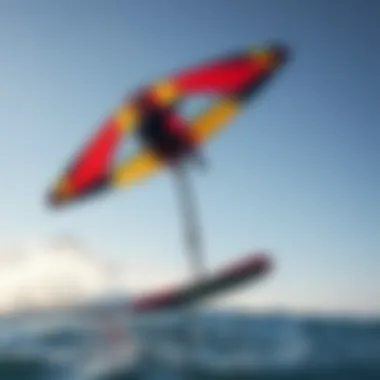
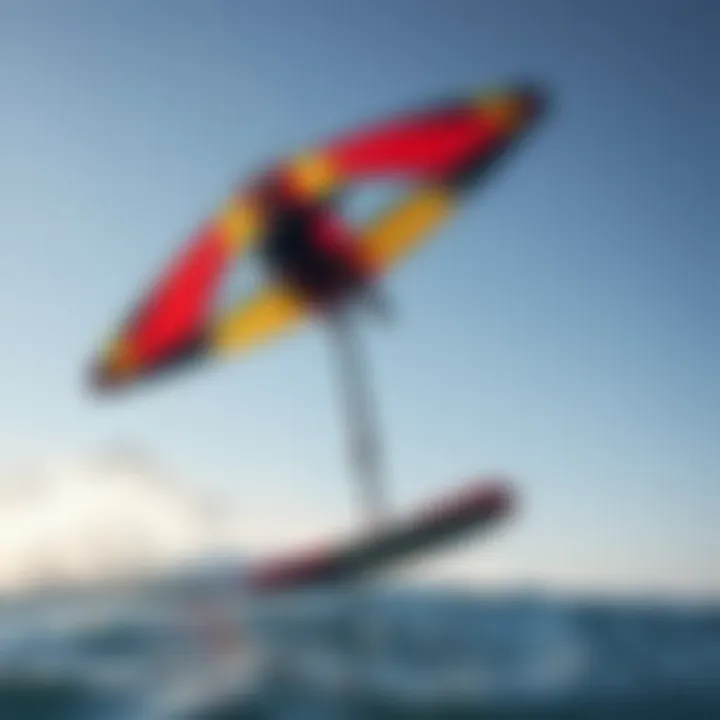
Intro
Hydrofoil kiting is a thrilling sport that marries the exhilaration of kiteboarding with the unique dynamics of hydrofoiling. This practice has gained in popularity, offering riders a mesmerizing experience as they glide above the water. For both budding kiteboarders and those with a few seasons under their belts, understanding hydrofoil kiting is essential for enhancing skills and safety.
In exploring hydrofoil kiting, we'll delve into essential gear, safety practices, and techniques to elevate your performance on the water. With this guide, you can ride the waves like never before, enjoying a sense of freedom only achievable with a foil beneath your board. Whether you're seeking to refine your approach or take your first steps, this article breaks down everything you need to know.
Gear and Equipment
Gear plays a pivotal role in hydrofoil kiting. Having the right equipment ensures not only better performance but also greater safety. Here’s a closer look at what you’ll need to get started, as well as what experienced riders should consider.
Essential Kiteboarding Gear for Beginners
For those just dipping their toes into the hydrofoil world, a few key pieces of equipment can make all the difference:
- Kite: Start with a reliable and well-reviewed model suited for your local wind conditions. Brands like Cabrinha and Naish offer a variety of options.
- Hydrofoil Setup: Choose a foil that balances lift and stability. Many beginners start with a freeride foil that allows for easy take-offs and landings.
- Board: A larger beginner board can help with stability while you get the hang of things. Consider a board that complements your foil choice.
- Harness: A comfortable harness is crucial. Look for one that provides good support and fits securely but doesn’t restrict your movements.
- Safety Gear: Always invest in a quality impact vest and a helmet. These can save you from injuries.
Advanced Equipment for Experienced Riders
Once you’ve got the basics covered, exploring advanced gear will open up new realms of performance. Some key items for seasoned riders include:
- High-Performance Kite: Consider kites that allow for better control and speed, such as the Flysurfer Soul or F-One Bandit.
- Sleek Hydrofoils: Advanced riders often choose high-aspect foils that are designed for speed and agility.
- Carbon Boards: This lightweight option enhances maneuverability, making tricks easier to execute.
- Smart Accessories: Things like a good GPS for tracking performance stats can help you fine-tune your skills. Look into devices from brands like Garmin.
"Investing in your gear is investing in your future as a rider. Choose wisely!"
Techniques and Tips
Empowering yourself with the right techniques can greatly impact your experience on the water. Here’s a rundown of essential practices and strategies for every level of kiteboarder.
Safety Practices for Kiteboarding
Safety is paramount in hydrofoil kiting. Here are some essential safety practices:
- Understand Wind Conditions: Know the safe wind range for your equipment before heading out.
- Check Your Gear: Inspect lines, knots, and the kite for any wear and tear before each session.
- Notify Others: Make sure someone knows where you're kiting, especially if you're heading to less-frequented spots.
- Practice Self-Rescue Techniques: Know how to manage emergencies effectively. Review rescue techniques periodically.
Training Techniques to Improve Your Skills
Enhancing your hydrofoil kiting skills takes dedicated practice and patience. Here’s how you can work toward becoming a more proficient rider:
- Drill Basic Maneuvers: Focus on take-offs and landings. These foundational skills can make or break a session.
- Experiment with Angles: As you gain confidence, play with different angles of your foil and kite. This can dramatically change your speed and lift.
- Video Analysis: Recording your sessions can help identify areas for improvement. Review the footage to refine your technique.
- Join a Community: Engaging with other riders can provide valuable insights. Sites like reddit.com or local kiteboarding groups on Facebook are great resources.
By keeping gear in check, prioritizing safety, and honing your skills, hydrofoil kiting can transform from a hobby into a thrilling passion. Whether you’re catching the wind for the first time or you’re a seasoned pro, there is always room for growth in this electrifying sport.
Intro to Hydrofoil Kiting
Hydrofoil kiting presents a fascinating frontier in the world of kiteboarding, marrying traditional kite-powered riding with the innovative technology of hydrofoils. As a practice, it's not just about gliding across the surface of the water; rather, it opens up a realm of possibilities for those seeking to elevate their experience—literally and figuratively. Engaging in hydrofoil kiting allows riders to fly above the water, experiencing the thrill of speed while enjoying an exhilarating freedom only achievable when harnessing wind and water together.
This section serves as a gateway into understanding not just what hydrofoil kiting is, but also why it holds significance in the broader landscape of water sports. Not only do you learn about the advanced gear and techniques, but you also come to appreciate the safety measures that ensure a fun yet responsible approach to this sport. In other words, hydrofoil kiting is not merely a trend; it’s a skillful dance that combines art, science, and a touch of daring.
The Concept Behind Hydrofoil Kiting
At its core, hydrofoil kiting operates on a simple yet profound principle: lift generated by a hydrodynamic foil submerged beneath the water surface. When a rider gains speed, typically by steering a kite caught in the wind above, the foil begins to lift the board—and the rider—out of the water. This elevates the experience, minimizing drag and allowing for smooth sailing even in marginal wind conditions.
The hydrofoil itself is attached to a board, and it operates somewhat like an airplane wing; different shapes and sizes influence how smoothly and efficiently a rider glides. Riders who master this technique can shift their body weight and manipulate the kite to adjust speed and direction effortlessly. When everything comes together, a rider can achieve an almost magical sensation of flying above the water’s surface.
One must remember that hydrodynamics plays a crucial role here. Getting accustomed to the intricacies of these dynamics requires practice, keen observation, and patience. Engaging in hydrofoil kiting is an opportunity to form a deeper connection with nature as you flow in harmony with both the elements and your equipment.
Comparing Hydrofoil Kiting to Traditional Kiteboarding
When comparing hydrofoil kiting to traditional kiteboarding, one is immediately struck by a few key distinctions that can affect a rider's overall experience. Traditional kiteboarding typically keeps riders on the water's surface, relying heavily on the power of the kite and the wind. While still exhilarating, this method faces limitations when it comes to choppy water or challenging wind conditions. And, sure, you may enjoy a good splash; however, many enthusiasts find the allure of hydrofoiling compelling due to its unique advantages.
One of the most noticeable differences is the reduced drag. Hydrofoils slice through the water efficiently, which not only means smoother rides but also opens the door to greater speeds. This efficiency allows a rider to carve turns and maneuver in ways that standard kiteboarding struggles to achieve, especially when the wind dies down or when facing waves.
On the gear front, hydrofoil setups tend to be more complex than a regular kiteboard due to the requirement for a hydrofoil, which adds an additional layer in terms of weight distribution and balance. Thus, while both practices have their charm, hydrofoil kiting takes things to an advanced level, making it appealing for those who have already mastered the basics of kiteboarding and yearn for something more.
History of Hydrofoil Kiting
Understanding the evolution of hydrofoil kiting is crucial for both newcomers and experienced practitioners. This aspect not only highlights the ingenuity behind the sport but also reveals how techniques and equipment have grown over time. Diving into the history presents a pathway to grasp the current advancements and appreciate the journey that the sport has undertaken.
The story of hydrofoil kiting is not just one of innovation; it's also filled with tales of trial and error that have shaped its current form. Knowing about its roots can enrich a rider's experience and inform their practice. Just like a tree with deep roots, the more one understands the foundation, the better they can appreciate the fruits of its progress.
Origins of Hydrofoil Technology
Hydrofoil technology isn't new; it traces back to the early 1900s with inventors like Emmanuel de Bastier de la Rivière and later, the famed aeronautical engineer, Alexander Graham Bell. They explored the physics behind foils—wings submerged partially in water that lift above the surface as speed increases, reducing drag. This principle was utilized in boats for improved speed and efficiency.
Early hydrofoils were experimental, representing the breaking of conventional barriers in watersports. In the 1960s, the technology saw some integration into watercraft, mainly for speed enthusiasts. However, the leap towards kiting emerged later, combining traditional kites with hydrofoil designs.

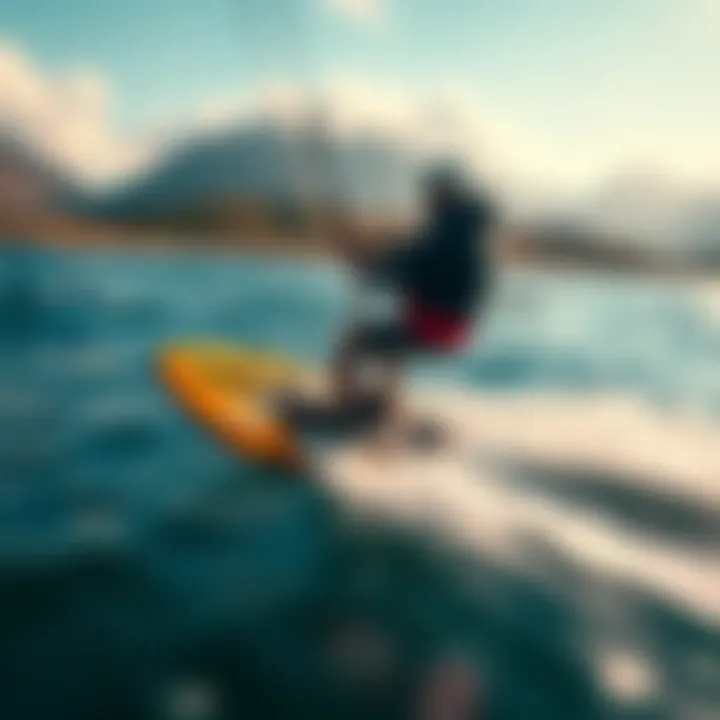
"From its nascent beginnings to its present twist, hydrofoiling is akin to a dance between innovation and nature's forces."
The 1990s saw a burgeoning interest in combining these innovative foils with kiteboarding. Here, enthusiasts began experimenting with materials and designs aimed at stability and performance. The union of kites and hydrofoils established a whole new realm of possibilities for riding techniques.
Milestones in Hydrofoil Kiting Development
The journey of hydrofoil kiting is marked by several pivotal milestones that have shaped it into what we see today. In the late 1990s, developments in kite technologies were point of major excitement. Early kites like the Wipika Airfoil captured attention for introducing a new aspect of aerial control, which played into the hands of experimental hydrofoil riders. The infusion of inflatable kites opened doors to broader applications and possibilities.
In the 2000s, manufacturers began to refine both kites and hydrofoil boards, focusing on improved materials and fabrication techniques. Companies like Naish and Slingshot innovated designs that catered directly to hydrofoil performance. The hydrofoil's shape evolved, balancing efficiency and maneuverability, making it more user-friendly.
The introduction of adjustable foils around 2010 also became a significant game-changer. Designed with interchangeable parts, riders could now customize their setups for various conditions, thus enhancing versatility.
Today, with advancements in technology, hydrofoil kiting has gained a global community of avid practitioners. Online forums, social media, and dedicated events continue to spread knowledge, fueling the sport's growth.
As a result, the timeline of hydrofoil kiting development reflects a fascinating interplay of individual creativity and collective advancement, urging each rider to contribute to the vibrant tapestry of kiting history.
Essential Gear for Hydrofoil Kiting
When it comes to hydrofoil kiting, the gear you choose can make or break your experience on the water. The right equipment not only ensures your safety but also enhances your performance, making it essential for both beginners and seasoned enthusiasts to understand the gear required. This section covers the key elements of hydrofoil kiting gear, focusing on different setups and their benefits, kite specifications, and necessary safety accessories. Choosing wisely can lead to better handling in challenging wind conditions and an overall enjoyable kiting adventure.
Choosing the Right Hydrofoil Setup
Different Types of Hydrofoils
Hydrofoils come in various types designed for specific riding styles and conditions. Generally, there are three primary categories: freeride foils, freestyle foils, and race foils.
- Freeride foils cater to those looking for versatility, allowing for easier launches and softer landings. They offer a great balance between lift and control, making them popular for newcomers.
- Freestyle foils feature a lighter construction, enabling better maneuverability for performing tricks. Although they provide incredible responsiveness, they might require more finesse to control.
- Race foils, on the other hand, prioritize speed and efficiency. They often come with larger wings, which can help maintain flight at higher speeds but might be a bit more challenging to control for less experienced riders.
Choosing the right hydrofoil can significantly impact your ride. For example, a freeride foil is particularly beneficial for those still mastering the basic skills, while a race foil might suit more advanced riders seeking to push their limits at speed.
Size Considerations
Size plays a crucial role in the performance of your hydrofoil. The size of the foil’s wing relates directly to the lift it generates and, ultimately, how it handles in various wind conditions. Larger wings typically provide more lift at low speeds, making them favorable for lighter winds or heavier riders. In contrast, smaller wings can offer less drag and higher speeds in strong winds, appealing to experienced kitesurfers.
Consider the area of the wing as a key characteristic when selecting a hydrofoil. For instance, a larger wing can be advantageous for beginners, as it reduces the chances of crashing during take-off. However, using a smaller wing provides better agility and efficiency once riders gain confidence, allowing for quicker turns and higher jumps. Thus, the choice of size should align with your skill level and riding style.
Selecting the Proper Kite
Kite selection is equally critical as it determines how you'll interact with the wind to achieve the lift necessary for hydrofoiling. The kite’s size and shape, along with the materials used, can influence your control and stability while in flight.
Kite Size and Shape
In the world of kites, size matters. Bigger kites capture more wind, while smaller kites are easier to handle in strong winds. It's vital to consider not just the size but the shape, as they dictate how the kite behaves.
For instance, flat kites tend to have high stability and ease of control compared to bow kites, which are known for their re-launch capabilities and high performance in low wind. Choosing the right size and shape for your riding style is crucial. A larger kite can facilitate easy lifting in lighter winds but may be unwieldy in stronger gusts, making it a less desirable choice in those conditions.
Material and Durability
The durability of your kite is influenced primarily by the materials from which it’s made. Modern kites often use ripstop nylon or polyester due to their strength and lightweight nature. Wind-resistance and durability are key aspects here. It’s essential to remember that a sturdier kite will withstand the wear and tear associated with frequent use, especially in varying conditions which are pretty common in hydrofoil kiting.
Investing in quality material, such as Dacron ribs or reinforced seams, can enhance the longevity of your kite. While it might come with a higher price tag, a well-constructed kite can save you a lot of money over time, as it reduces the chance of tear or malfunction during use.
Safety Accessories for Hydrofoil Kiting
Safety should always be at the forefront when engaging in any water sport. Having the right accessories not only protects you but can also significantly contribute to a more enjoyable experience.
Impact Vests
Impact vests are a crucial component of hydrofoil kiting gear. They provide necessary buoyancy and protection against crashes, which can happen unexpectedly at higher speeds. These vests are typically designed to absorb shock during impacts, reducing the risk of injury significantly.
Opting for an impact vest that fits snugly is essential. A vest that is too loose can ride up or shift during use, negating its intended protection. Moreover, many riders appreciate the additional flotation it provides, aiding in water recovery post-fall.
Helmets and Safety Leashes
Helmets have become a must-have for hydrofoilers due to the increased risks involved. They safeguard your head against potential collisions with your foil or other objects in the water. The available options range from lightweight designs that provide comfort without overheating to more robust models suitable for aggressive riding.
Safety leashes also play a vital role in ensuring your kite doesn’t drift away and cause accidents should you fall. A safety leash keeps your kite tethered to you, allowing for a quicker return to kiting without having to chase after your gear. While some might see it as a secondary accessory, having a well-functioning safety leash can make all the difference amidst sudden changes in conditions.
Basic Techniques for Hydrofoil Kiting
In the realm of hydrofoil kiting, honing basic techniques is pivotal for anyone wanting to glide above the waves with confidence. Mastering these fundamentals not only sets the stage for more advanced maneuvers but also enhances safety and enjoyment. These techniques lay a solid foundation that can lead to exhilarating experiences on the water. Whether you're a wide-eyed beginner or a seasoned kiteboarder trying to level up, getting comfortable with these core skills will take your hydrofoil kiting game to new heights.
Getting Started: The Learning Curve
Framing the conversation about hydrofoil kiting, the learning curve can seem steep, but it doesn’t have to be. Initially, a rider faces a unique challenge—getting the foil to lift and maintaining control over both the kite and the board simultaneously. From my own experiences, one of the best pieces of advice is to start slowly, allowing yourself to familiarize with the feel of the hydrofoil under your feet. Patience plays a crucial role.
A good way to shave off some of those initial struggles is by practicing in relatively calm waters. Places like flat lakes or sheltered bays will help new riders avoid the complications that can arise in choppy oceans. It's a bit like trying to learn how to ride a bike in a windstorm—much easier on a smooth road.
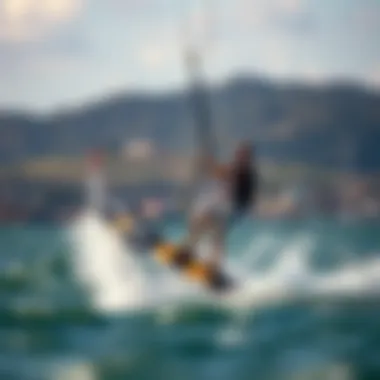
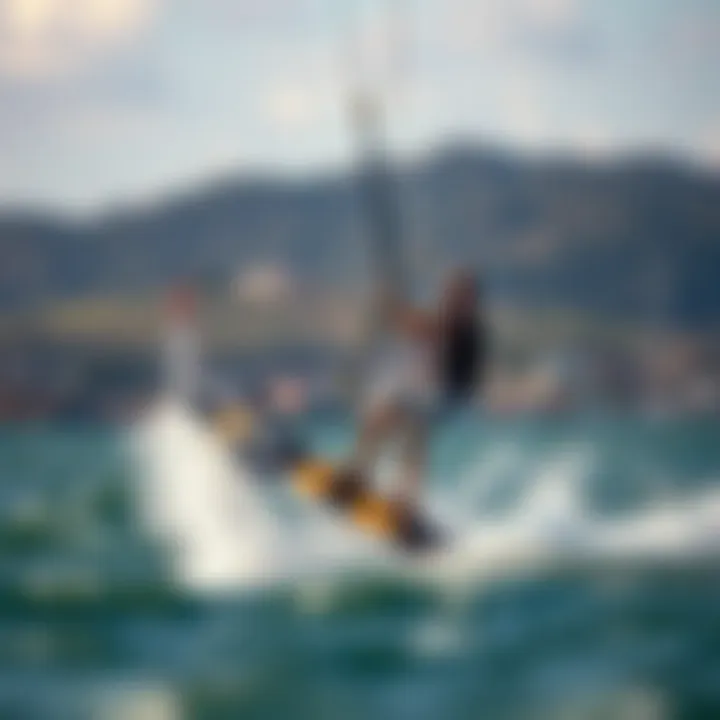
Fundamentals of Riding a Hydrofoil
The essence of riding a hydrofoil hinges on understanding the interactions between the kite, board, and water. When the foil begins to lift, it’s important to keep your movements subtle and fluid. Pressing down lightly on the back foot leads to lift, while shifting your weight forward helps you dive back down into the water. It’s a balancing act, which might make you feel like a tightrope walker at first.
Getting comfortable with controlling your speed is also essential. Hydrofoils can glide with minimal resistance, so speeding up or slowing down requires finesse. A common mishap is suddenly increasing speed, which can send the rider tumbling—hence it's crucial to learn smooth acceleration and deceleration techniques. Ultimately, this balance of speed and control creates a dance between rider and equipment.
Balance and Weight Distribution
Achieving proper balance and weight distribution is vital. It’s akin to the principle of keeping your center of gravity low when you’re dodging through a crowd—moving too fast or leaning the wrong way will often lead to a fall. In hydrofoil kiting, your body should remain aligned directly over the foil. If you find yourself leaning too far forward or backward, you’ll tip easily!
To develop this skill, many riders practice on land with their hydrofoil to get a sense of where their weight needs to be. When actually on the water, slight adjustments in stance can make a massive difference in how stable you feel. Try to keep most of your weight centered over your front foot for better lift, but avoid leaning too far forward as this can push the foil under the water, creating a top-heavy sensation.
"The key to harnessing the hydrofoil's power is maintaining balance and feel, adapting to the waves and the wind like a seasoned sailor navigates through changing tides."
Advanced Hydrofoil Kiting Techniques
Diving into advanced hydrofoil kiting techniques opens up a whole new world for enthusiasts. It’s not just about riding on the water; it’s about harnessing the potential to perform spectacular maneuvers and master speed. Understanding these techniques can significantly enhance the overall experience, making hydrofoil kiting a thrilling adventure rather than just another activity on the water.
The capacity to transition from basic riding to tricks showcases personal progress and can truly elevate the enjoyment of the sport. Alongside this, the learning curve associated with advanced techniques fosters a sense of accomplishment and boosts confidence, keeping riders motivated to push their limits.
Progressing to Tricks and Maneuvers
Mastering jumps and fluid transitions are principal components of escalating your hydrofoil kiting prowess.
Jumping Techniques
Jumping techniques form a fundamental aspect of advanced hydrofoil kiting. They are not merely acrobatics; they provide a unique thrill that is integral to the appeal of this sport. The ability to leap into the air not only adds fun but also improves your overall control of the kite and board. A critical feature of jumping is timing; aligning the force from the kite with your weight distribution can generate an incredible lift.
These techniques are popular for riders looking to combine style with aerial achievements, and they offer a breathtaking spectacle on the water.
However, there is a catch. Jumping requires skill and precision. If set off incorrectly, it can lead to nasty tumbles or falls. To make the most out of jumping, persistent practice and understanding of your gear are necessary.
Fluid Transitions
Fluid transitions, on the other hand, focus on the glide and flow of movement. This aspect of hydrofoil kiting emphasizes seamlessly changing directions and styles without losing speed or momentum. What sets fluid transitions apart is the ability to maintain a low profile—riders can shift gracefully from one maneuver to another, resembling a dance on water.
This technique’s allure lies in its adaptability; it's a skill that almost all other advanced techniques rely on. Fluid transitions promote better efficiency in maneuvers and are essential for doing tricks in succession.
However, mastering this technique also demands practice and patience. If done incorrectly, it can end up looking more like a stumble than a smooth transition.
Mastering Speed and Control
Speed and control are the bread and butter of hydrofoil kiting. The balance of these two elements is crucial for riders who want to continue progressing. Recognizing how to manipulate your speed not only enhances your ability to perform tricks but also ensures you can navigate challenging conditions with ease.
Tip: Always remember to maintain a strong core; having a solid core contributes significantly to your overall balance and capability to handle fast speeds. The relationship between speed and control makes advanced hydrofoil kiting an intricate dance where precision and technique take center stage.
In summary, mastering advanced hydrofoil kiting techniques transforms the ordinary into the extraordinary. These techniques demand dedication, yet they grant riders exhilarating experiences and elevate their skills to new heights.
"The journey of mastering hydrofoil kiting is paved with challenges, but each twist and turn offers reward beyond measure."
For more insights and resources, consider visiting sites like Wikipedia, Britannica, and forums on places like Reddit for community advice and experiences to enrich your learning.
Hydrofoil Kiting Locations
Hydrofoil kiting opens up a world of adventure for kiteboarders seeking new challenges and landscapes. Locations play a crucial role in shaping the kiting experience, impacting everything from safety to performance. Choosing the right spot can elevate your skills and enjoyment, ensuring that every outing is memorable.
Best Spots for Hydrofoil Kiting Globally
Top Destination Highlights
When it comes to hydrofoil kiting, spots like Hood River in Oregon stand out. This area is famous for its consistent winds and diverse water conditions, making it a hotspot for kite enthusiasts. The Columbia River Gorge provides various launch sites, catering to both beginners and experienced riders alike.
Moreover, the pristine beaches of Mauritius boast ideal conditions with warm waters and steady winds, delivering a postcard-perfect backdrop. The island's flat lagoons and coral reefs allow for smooth rides, ideal for practicing tricks or simply floating along.
Why these locations? The common thread through these sites is the reliable wind patterns and the richness of natural beauty, making them popular choices among the kiting community. Their unique features, like shallow sandy areas and expansive open spaces, minimize hazards while maximizing fun.
Seasonal Conditions and Trends
Understanding seasonal trends plays a part in maximizing your hydrofoil kiting experience. For example, kiteboarding locations such as Cape Town, South Africa, offer a strong wind season from late October to March. During this time, the notorious Cape Doctor wind brings consistent gales, perfect for high-adrenaline sessions. In contrast, summer months see lighter winds, which could require a different approach or gear adjustments.
Wildlife factors also influence seasonal conditions. Some national parks may have seasonal restrictions on water sports during breeding seasons of local wildlife. Thus, checking local regulations and seasonal patterns can prevent you from having an off day on the water.
Local Conditions to Consider
While global spots get the spotlight, local conditions can make or break your hydrofoiling experience. These are essential elements to keep in mind before heading out.
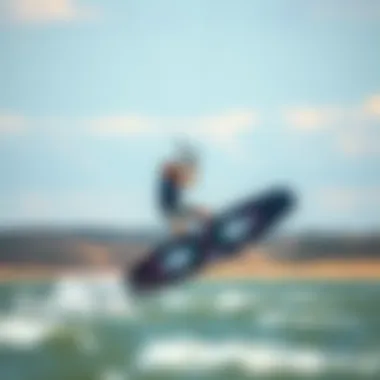
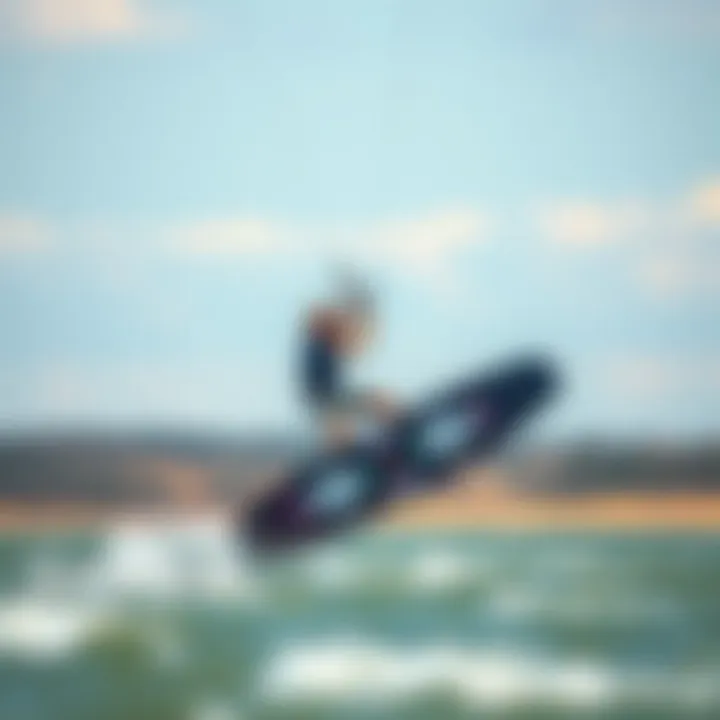
Wind Patterns
Wind patterns determine the dynamics of a kiting session. Mastering local wind features—like thermal winds or sea breezes—can directly affect your ride. Locations such as the Outer Banks in North Carolina benefit from steady trade winds, making it an excellent choice for practitioners.
Why does this matter? Local wind attributes can change dramatically; for instance, gusty conditions can lead to unexpected challenges. Thus, being aware of these elements helps riders make better decisions about timing and gear.
Water Depths
Water depths play a large role in safety and performance. Riding in shallow waters, like those found in shallow bays, can offer unique challenges but also promote safer landings and transitions. This is especially important for less experienced riders who are still dialing in their skills. However, deeper waters can increase the potential for speed and performance, allowing for greater freedom when executing tricks.
Key takeaway: Checking water charts for depth variations based on tidal conditions is advisable. This way, you can select the most suitable spots and enjoy your time on the hydrofoil without the worry of unexpected bumps or crashes.
In summary, selecting the right hydrofoil kiting locations and understanding local conditions is critical for enhancing your experience. By considering factors like wind patterns and water depths, you position yourself for successful and enjoyable sessions out on the water. Keep exploring new territories, and don’t be afraid to try different spots!
Maintenance and Care for Hydrofoil Gear
Proper maintenance and care for your hydrofoil gear go a long way in ensuring not only its longevity but also enhancing your overall kiting experience. The equipment you use, including the hydrofoil itself, the kite, and other accessories, are all subject to wear and tear due to their exposure to saltwater, sun, and physical impact. A little diligence in caring for your gear means less hassle and more time spent riding the waves. Keeping gear in tip-top shape allows kiters to enjoy more consistent performance and reduces the risk of equipment failure when you're out on the water.
Cleaning Protocols After Use
After every session, you will want to give your gear a good rinse. This is not just for show; saltwater can be particularly corrosive, and any debris like sand or dirt can wear down components over time.
- Rinse Thoroughly: Use fresh water to wash off your hydrofoil parts, the kite, and bar. Make sure to focus on the connections and joints where salt can build up.
- Inspect for Damage: While rinsing, keep an eye out for any signs of wear. Look for scratches on the foil wings or fraying in the kite fabric. The sooner you catch these issues, the less likely they are to become major problems.
- Dry Properly: After rinsing, it’s essential to air dry the gear. Hang the kite and let it fully dry before packing it away. Avoid leaving it in direct sunlight for too long, especially if you can help it. Too much sun can degrade the fabric over time, leading to issues later on.
"An ounce of prevention is worth a pound of cure."
Implementing these cleaning steps creates a robust preventive maintenance culture, vastly improving the lifespan of your gear. Neglecting to clean it can leave you with a high-priced doorstop instead of functional, reliable equipment.
Long-term Gear Storage Techniques
When it's time to put your gear away, especially at the end of a season, how you store your hydrofoil can affect its performance when you bring it back into action.
- Cool, Dry Place: A garage or a climate-controlled closet is ideal. Keeping gear away from extreme temperatures and humidity levels helps maintain the integrity of materials.
- Avoid Compression: Store your hydrofoil and kite flat or uncompressed. If you pack your kite into a tight bag, it risk developing creases over time, impacting its aerodynamics when you take it out again.
- Check for Insects: Rodents or bugs can be an unexpected hazard; make sure your storage area is free of any potential nests or little critters.
- Regular Check-ins: Every so often, open your stored gear to check for any signs of mildew or deterioration. This will ensure that your gear is ready when you are, rather than being a source of disappointment.
By following these maintenance practices, kiteboarders will find that their gear stands the test of time, providing reliable performance for countless sessions in the water. Keeping things in order is not just a chore but the key to a smoother, more enjoyable hydrofoil kiting experience in the long run.
Safety Considerations in Hydrofoil Kiting
Hydrofoil kiting provides an exhilarating experience on the water, but safety should never take a backseat. Understanding the various risks associated with this sport is crucial for both new and seasoned riders. This section addresses essential safety considerations, ensuring that fun and safety go hand in hand.
Identifying Hazards on the Water
When engaging in hydrofoil kiting, it is imperative to be vigilant about potential hazards that could jeopardize your safety. Here are several hazards to consider:
- Obstacles Underwater: Rocks, reefs, and other submerged structures can pose serious risks. It’s advisable to scout the area or consult local knowledge before hitting the water.
- Wind Conditions: Unpredictable wind patterns can turn a pleasant kiting session into a challenging situation. Always check local wind forecasts and be ready to adjust your plans accordingly.
- Other Water Users: Busy waterways may have boats, jet skis, or other kitesurfers. Being aware of your surroundings and following right-of-way rules is essential for preventing collisions.
- Changing Water Depths: Sudden shifts in depth can be hazardous. Know the area’s tides and be cautious in shallow spots to avoid falls or equipment damage.
"A solid understanding of potential hazards is integral for enjoying hydrofoil kiting to the fullest. Stay aware!"
Recognizing these dangers can significantly reduce the risk of injury or accidents. Taking proactive measures, such as using a helmet and impact vest, will further enhance safety.
Emergency Protocols and Rescue Techniques
Despite all precautions, accidents can happen. That's why having a solid plan and understanding emergency protocols is paramount when hydrofoil kiting.
- Learn Rescues Basics: Familiarize yourself with self-rescue techniques, such as releasing your kite and swimming back to shore. Make sure you practice this in calm conditions to feel more confident.
- Buddy System: Kiting with a partner can greatly enhance safety. If something goes awry, your buddy can provide immediate assistance, whether that’s rescuing you from the water or helping deal with equipment issues.
- Communicate: Always discuss your plans before heading out. Let others know your route and when you expect to return. This improves safety in case anything goes wrong.
- Signal for Help: If you find yourself in a tricky situation, use universally recognized signals—such as waving an arm or your kite—to indicate distress. Have a whistle attached to your life jacket for improved visibility and sound.
By preparing for potential emergencies, hydrofoil kiters can enjoy their time on the water with greater peace of mind, knowing they have a plan in place.
The Future of Hydrofoil Kiting
The world of hydrofoil kiting is constantly evolving, and understanding its future is both exhilarating and pivotal for enthusiasts and newcomers alike. As technology advances and the community grows, several elements come into play that are essential to grasp. This section will explore technological innovations and shifting trends that shape the landscape of hydrofoil kiting, providing insights into what to expect moving forward.
Technological Innovations on the Horizon
The advancement of technology in hydrofoil kiting is akin to putting rocket fuel into an already thrilling experience. Devices and gear are becoming lighter, stronger, and smarter. One of the most noteworthy innovations is the development of electric hydrofoils, which offer another dimension of freedom. These setups allow riders to glide effortlessly over water without relying solely on wind conditions, thus opening up kiting possibilities in smaller lakes or during lighter breezes.
Moreover, materials used in hydrofoil design are continually improving. For instance, the introduction of carbon fiber has reduced weight drastically while also increasing strength. This benefit enhances performance, making for a more responsive ride.
Features like integrated GPS technology and altitude sensors are also making waves. Riders can now have real-time feedback, helping them refine their technique while riding and pushing their limits with calculated risks. For those keen on data, applications tied directly to riding gear are starting to emerge, allowing riders to log their performance metrics and assess their progress.
"The thrill of kiting is not just in the ride, but in the discovery of new horizons made possible by innovation."
As these technologies develop, accessibility for new riders increases. These innovations cater to all levels, allowing beginners to harness advanced capabilities and experienced riders to push their skills to the edge.
Shifting Trends in the Hydrofoil Kiting Community
The hydrofoil kiting community is experiencing a shift that reflects broader trends in adventure sports. There’s a noticeable movement towards environmental consciousness. Riders are becoming increasingly aware of their impact on nature, leading to an emergence of sustainable practices. Not only are materials being selected for their performance, but also for their ecological footprint.
Another trend is the rise in popularity of hydrofoil racing events. These competitions are drawing attention and bringing a competitive edge to casual riding. The thrill of racing against fellow enthusiasts creates camaraderie while elevating skill levels across the board. Communities are beginning to form around local events, encouraging collaboration and support among participants.
Social media platforms play a significant role in these trends, with influencers showcasing their rides, gear tips, and unique locations. This visibility creates a thriving marketplace and community, sharing techniques and experiences like never before.
As hydrofoil kiting continues to forge its path, the blending of these trends hints at a vibrant future. Technology will usher in new possibilities while the community nurtures a culture centered around sustainability and collaboration.



